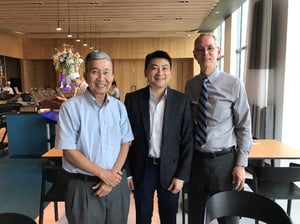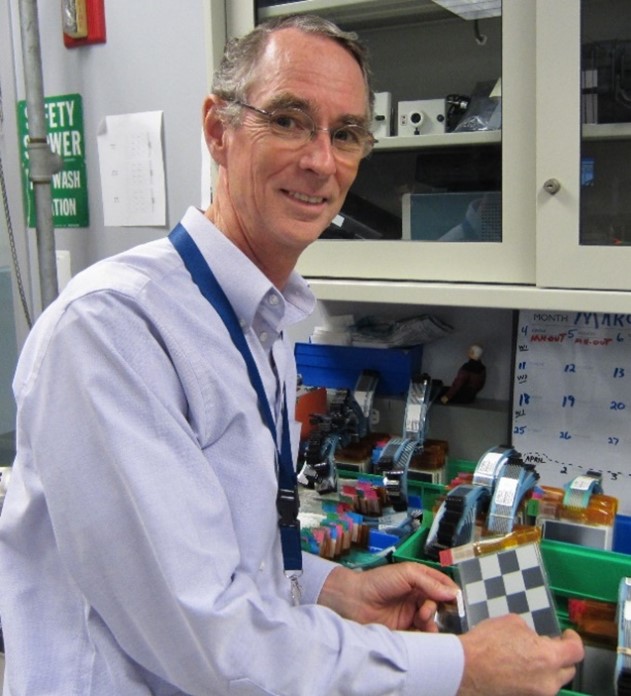From an early start up to a global enterprise, Chief Innovation Officer Michael McCreary has been with E Ink from almost the founding of the company.
Looking back at his career, some of the most challenging times were ones that opened pathways to new, rewarding opportunities. Mike’s journey to E Ink was guided by his passion, curiosity, and adaptability to change, and resilience.
We’re excited to have Mike join this week’s “Ask an Inker” blog.
Tell us about your career journey. How did you land at E Ink?
My journey to E Ink started with a passion for science and imaging as a teenager. I already loved chemistry and physics in the 10th grade and was a photographer for the school newspaper, developing my own film and printing my own photographs. This was the beginning of my deep interest in imaging. After obtaining my PhD from Massachusetts Institute of Technology (MIT) in physical organic chemistry, I wanted to do something that allowed me to use my academic background in photography.
In 1973, I landed at Kodak as a photographic scientist. The beginning of my career there was exciting, including the development of the new Kodak instant photography developer chemistry.

Mike (right) with former colleague Ching Wan Tang (left), who invented OLED at Kodak and was inducted into the National Inventors Hall of Fame in 2018.
Credit: E Ink
That work came to an abrupt end however with Kodak’s loss to Polaroid in a lawsuit over intellectual property. At the time, digital imaging was already beginning to disrupt traditional films and I made the choice to go back to school in solid state physics and move to a division developing world record solid state image sensors. But by the late 1990s, Kodak was struggling in its photographic divisions and layoffs were taking place across the company. It wasn’t a happy place.
So when I got a call from a headhunter in 2000, I listened. It was a small MIT Media Lab spinout called E Ink, looking for somebody to head up Research and Development (R&D). What drew me in and made me accept the offer from E Ink was the amazing energy and passion I experienced from the team.
Looking back, after being with E Ink for 23 plus years it has been an amazing journey. I’m grateful that I made the decision to join E Ink and move into the future of digital imaging rather than hold onto the past of photography.
What was your first impression of E Ink technology?
I had not heard about E Ink before I joined the company, but I knew about the technology before it was spun out because I had seen it during a visit to the MIT Media Lab. It was pretty rough at that time and it was easy to underestimate the future impact of the display. But the concept of having a library in people’s hands, even when they’re traveling, not having to cut down trees, and reducing paper waste was compelling. So, I accepted the job offer. Since those early days, E Ink has indeed changed the world of reading in a big way.
e.

Mike as CTO at E Ink in 2012.
Credit: E Ink
Today, that core vision – sustainable technology that businesses can adopt to reduce their impact on the environment – still guides our technological development.
What do you see as next on the horizon for innovation in the signage industry?
Reflective, paper-like, daylight readable color signage is a huge opportunity for 2024 and beyond. I look forward to seeing color E Ink displays enabling new applications. Larger area displays, indoor and outdoor signage – we are now seeing many customer products getting ready to move into the market…and this is just the beginning of E Ink color displays.

Launched in early 2023, E Ink Spectra 6 is a revolutionary new color product geared for in-store advertising and indoor displays to replace paper signage.
Credit: E Ink
What’s a piece of advice you’d like to give to other technology and innovation leaders as they continue their digital transformation journey?
It’s important to focus on the present but also to not neglect the longer-term future. Innovation leaders need to not only deliver products that are relevant to the customer’s business today, but also have a technology vision that helps ensure long term success.
Ask yourself: what is the world going to be like five years from now? What about ten years? What’s going to happen as we start to overlay artificial intelligence on everything?
A piece of advice I have for leaders is to think about what the disruptors to their business could be and have a long-term strategy in place that addresses market challenges early on and enables new opportunities.


Leave Comment